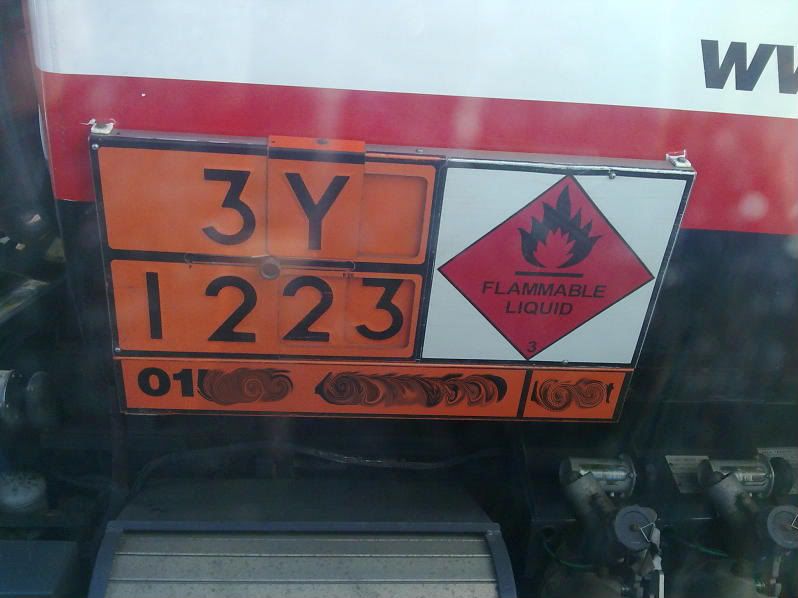cheers dave for the answer
dieseldave:
Written on ADR documentation correctly, what you’re carrying is:
UN 1978 PROPANE, 2.1 (B/D)
Transport Category 2The LQ code for propane is: LQ0, which means that there is NO LQ exemption available under ADR 3.4.6, however that’s got NOTHING to do with the 333kg nett ‘freebie’ limit, which is in ADR 1.1.3.6. (Very different.
)
Under ADR (by road) you get to carry 333kg nett of propane without the full weight of the ADR Regs applying to you, because it’s in Transport Category 2. This is a completely different exemption, because this exemption applies per vehicle NOT per package.
In practice, this means that you can carry propane in gas cylinders on a vehicle (truck) by road in quantities UP TO 333kgs nett. ( don’t count the gross weight of the cylinder in the calculation. )Therefore, you can carry any combination of cylinder sizes, PROVIDED that you don’t exceed 333kgs nett per vehicle.If you can comply with the above, all that needs to be on the vehicle is 1 X 2kg dry-powder fire-extinguisher. NO orange boards, NO ADR licence, NO Tremcard (IIW), NO extra vehicle equipment.
There’s one extra requirement for an international road journey: You will need a correctly completed ‘transport document,’ which can be a CMR, but I’d stress that the way of filling in the required info on a CMR is very important.As far as a sea journey by ferry is concerned when carrying <333kgs nett propane, the IMDG Code isn’t of concern to you, except…
You’ll need a multi-modal dangerous goods note (DGN) to present to the booking clerk, you’ll be issued 3 placards per vehicle carrying propane, which will need to be placed: one on each side and one on the rear
Size = 250mm X 250mm
You’ll also need to obey any instructions given by the ship’s crew with regard to where they want you to park your vehicle whilst it’s on the ferry.
TIP: Only place these placards on the vehicle(s) for the ferry journey, THEY AREN’T REQUIRED BY ROAD, so I’d remove them the minute you get off the ferry.
Dave.
Hi.
This is the biggest railroad known to TruckNet UK but rather than start a new thread I have used this one. ![]()
My question relates to carrying Methanol UN1230 and has the same basic properties.
UN1230
LQ 0
Transport Classification 2
We use the Methanol for racing and need to carry it in the van to race meetings, the cheapest way is for a few riders to club together and buy a 200 litre drum. Obviously it falls under the 333kg limit, so am I correct in advising the team that they do not need anything other than 1 x 2kg dry powder extinguisher?
I would also surmise that the occasional sea journey would use the same rules as above except for a class 3 placard.
Sorry about the diversion, choo choo ![]()
Wheel Nut:
This is the biggest railroad known to TruckNet UK but rather than start a new thread I have used this one.My question relates to carrying Methanol UN1230 and has the same basic properties.
UN1230
LQ 0
Transport Classification 2We use the Methanol for racing and need to carry it in the van to race meetings, the cheapest way is for a few riders to club together and buy a 200 litre drum. Obviously it falls under the 333kg limit, so am I correct in advising the team that they do not need anything other than 1 x 2kg dry powder extinguisher?
I would also surmise that the occasional sea journey would use the same rules as above except for a class 3 placard.
Sorry about the diversion, choo choo
Hi Malc,
No probs using this topic for your question, because that’s how it was set up by Site Admin. ![]()
Written correctly, what you’re carrying is:
UN 1230 METHANOL, 3(6.1), PGII, (D/E)
ADR Transport Category 2.
The primary hazard is that methanol is a flammable liquid (Class 3) but it’s also toxic enough to require a “toxic” secondary hazard label, hence the 6.1 in brackets. Both labels MUST be shown on the drum(s.) The (D/E) in the brackets [ADR tunnel code] must be there but isn’t in force just yet.
In the best traditions of this programme, here’s one I prepared earlier… ![]()
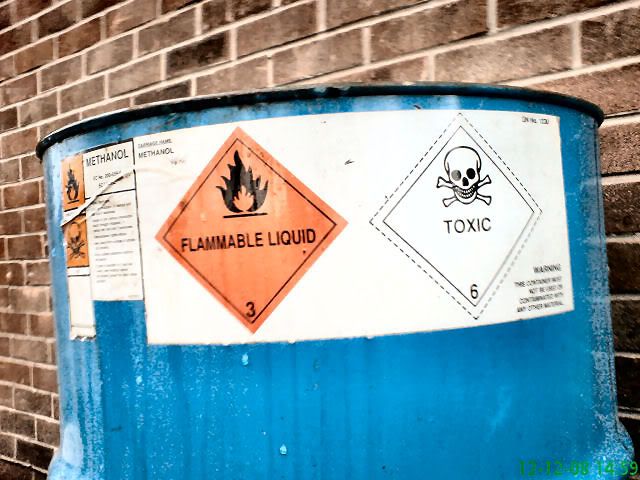
You’re absolutely spot-on in that the ADR limit for methanol is 333ltrs, but I’m wondering whether it might be a better idea to use 12 x 25 ltr drums/jerricans = 300ltrs, which just fits neatly within the limit for not requiring orange boards etc. Just an idea to allow you to carry more fuel. ![]()
Is 1x 200 ltr drum sufficient fuel for your team’s needs?
You’re also correct that 1 x 2kg dry powder fire extinguisher is a requirement, but please remember that it MUST be fully ADR compliant. The drum(s) must also be fully compliant in terms of bearing the correct UN approval and packaging code AND must be correctly secured against all movement whilst on board the vehicle.
The package code will be a minimum of:
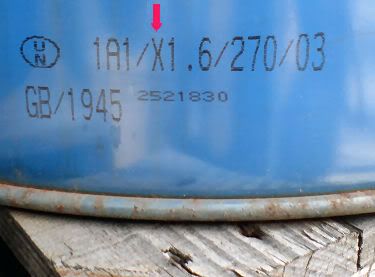
In order that you don’t get problems with IMDG (they can be very fussy ![]() ) I’ll stick to what types of packages are acceptable by both road AND sea for the carriage of methanol…
) I’ll stick to what types of packages are acceptable by both road AND sea for the carriage of methanol…
The drum(s) can be metal (1A1) or plastic (1H1,) but must be the fixed head ‘bung’ type.
Max size 400ltrs
(Clip tops ARE NOT allowed eg. 1A2 or 1H2)
Jerricans (elliptical cross-section) are allowed eg. steel (3A1) or plastic (3H1) max individual size 60ltrs.
The part of the code for drums/jerricans with the red arrow can be an “X” or a “Y,” but NOT a “Z.”
For the sea journey, under IMDG, you’ll need 3 x Class 3 placards and 3 x class 6.1 placards:
 …
… 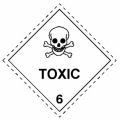
These are 250mm x 250mm minimum size.
You’ll also need a multi-modal DGN. I’d suggest that you only apply the placards to the vehicle once you’re in the docks and that you ensure that they come (fall ![]() ) off just as you’re coming off the boat, because they aren’t needed by road.
) off just as you’re coming off the boat, because they aren’t needed by road. ![]()
BTW, IMDG doesn’t regard methanol as a marine pollutant, so there’s no need for the triangular fish signs.
Under IMDG, methanol is in their stowage category “B.” (Clear of living quarters.)
Labelling
If the drum(s) / jerrican(s) are labelled as in the top picture, then that will comply with ADR and IMDG, because the two required class labels are present along with the UN number and the Proper Shipping Name (PSN.)
By road (ADR) there needs to be the UN number (plus the two class labels) on the package(s.)
An alternative method for displaying the UN number is a label like this:

IMDG requirements for labelling are the same as ADR, but with the addition of the PSN.
An alternative method for displaying the PSN for IMDG is a label like this:

If the PSN is shown on packages during road transport, then that isn’t a problem, it simply means that the packages exceed minimum labelling requirents by road.
I’d not bother with the channel tunnel if I were you… under their Regs, methanol is banned ![]()
I can help with obtaining the correct packages and labelling (at cost price) and with the preparation of the correct DGN if you need. (My own DGSA service and DGN is a freebie in your team’s case. ![]() )
)
I hope that helps. ![]()
A new set of UK dangerous goods Regs comes into force on 01/07/09.
It’s much thinner than previously, so that means that the UK is almost fully in line with ADR for UK domestic dangerous goods transport.
The main thing that folks will need to comply with is the ‘new’ four page version of Instructions In Writing (AKA a 'Tremcard.)
The old ‘single substance’ system is now no more, so here’s what’s new:
Key points:
- When a vehicle carries dangerous goods in excess of the relevant ADR Transport Category limit, the vehicle driver will need to be in possession of this new document.
- The responsibility for providing this document now rests with the carrier (vehicle owner.)
- The document consists of FOUR PAGES.
- The document MUST BE PRINTED IN COLOUR. (So, NO B&W photocopies.
 )
) - The document MUST be in a language that the vehicle driver understands.
- Even for international journeys, there is NO REQUIREMENT for foreign language versions as there was before.
- For UK use, the document can be printed ‘double-sided’ so only 2 sheets would be needed, but I stress- FOR USE IN THE UK.
- FOR INTERNATIONAL JOURNEYS, my advice is to print it on 4 sides of paper.
The main thing that folks will need to comply with is the ‘new’ four page version of Instructions In Writing (AKA a 'Tremcard.)
Key points:
- When a vehicle carries dangerous goods in excess of the relevant ADR Transport Category limit, the vehicle driver will need to be in possession of this new document.
- The responsibility for providing this document now rests with the carrier (vehicle owner,) NOT THE CONSIGNOR as previously
- The document consists of FOUR PAGES.
- The document MUST BE PRINTED IN COLOUR. (So, NO B&W photocopies.
 )
) - The document MUST be in a language that the vehicle driver understands.
- Even for international journeys, there is NO REQUIREMENT for foreign language versions as there was before.
- For UK use, the document can be printed ‘double-sided’ so only 2 sheets would be needed, but I stress- FOR USE IN THE UK.
- FOR INTERNATIONAL JOURNEYS, my advice is to print it on 4 sides of paper.
The downloadable/printable document (in English) is ![]() HERE
HERE
If anybody needs this document in any other language, please PM me a valid email addy and I’ll send it to you as a .pdf file. (Whilst not forgetting to say which language you need. ![]()
![]() )
)
I’ll then send you it as a .pdf file. ![]()
WARNING: Only the official versions are acceptable, so the four sides must be printed exactly as they are, but it is permissible to add extra info as required for certain dangerous goods on EXTRA sheets of paper.
Hi Dave just a question about DGN,s as we carry containers only, import & export when we carry a loaded container to the docks / raihead etc. for export we are given DGN,s & tremcard including the new tremcard as some company,s now don,t issue a tremcard as we carry the new ones with us .
The question is if we collect an import container from say a railhead or docks for delivery in the UK do we need to carry the DGN,s as well as the tremcard as one of our drivers was told by our office “Guru” (the shiny a**** pen pusher who knows it all) that you only need the tremcard when collecting an import container as DGN,s are only for the shipping co. and are not required for road transport on import containers?
Btw, I asked some time ago about prosecutions after a non-compliance PG9 (immediate or delayed) is issued in a “Hazmat” check and I have been told by a police officer that only the company is prosecuted for non-compliance and not the driver as it is the responsibility of the co. to ensure the driver is issued with the correct safety eqpmt. for ADR requirements / loads, bearing in mind it is still the responsibility of the driver to inform the co. that he / she is non-compliant and I would assume that there is the “Due Diligence” clause to absolve the driver of responsibility but I personally wouldn,t take the chance.
P.S. I did ring you last week to arrange a meeting but possibly you didn,t get the message on your voicemail or more likely I have the wrong no. for you!
NEJ:
Hi Dave just a question about DGN,s as we carry containers only, import & export when we carry a loaded container to the docks / raihead etc. for export we are given DGN,s & tremcard including the new tremcard as some company,s now don,t issue a tremcard as we carry the new ones with us .
Hi NEJ, The ‘Tremcard’ is the easiest thing to deal with first, so here goes:
From 01/07/09, it is the responsibility of the ‘carrier’ (the operator of the truck) to supply a four-page document to fulfil the ‘Tremcard’ requirement. That’s that, short and sweet.!!
My advice to companies operating in the UK is to print these ‘double-sided’ and laminate them to protect them. Printing them in colour IS a legal requirement.
If the company does this and issues it to every ADR qualified driver to put in their driver’s folder, then they are always available.
Compared to the old system, this seems to me to be extremely easy in terms of being able to be fully compliant, becase one document covers ALL classes of dangerous goods.
NEJ:
The question is if we collect an import container from say a railhead or docks for delivery in the UK do we need to carry the DGN,s as well as the tremcard as one of our drivers was told by our office “Guru” (the shiny a**** pen pusher who knows it all) that you only need the tremcard when collecting an import container as DGN,s are only for the shipping co. and are not required for road transport on import containers?
I’m not quite sure what the guy in your office actually means… maybe he doesn’t quite know for sure…
When a load (including a load carried in a container) is subject to ADR Regs, then there must be BOTH a ‘tremcard’ AND a ‘transport document’ on board the vehicle. There’s much myth surrounding a ‘transport document,’ but it doesn’t need to be anything too fancy.
As long as a DGN is correctly filled in and is acceptable to IMDG (they usually are) then a DGN actually more than meets ADR’s requirent for a ‘transport document.’ Again, that’s short and sweet.
NEJ:
Btw, I asked some time ago about prosecutions after a non-compliance PG9 (immediate or delayed) is issued in a “Hazmat” check and I have been told by a police officer that only the company is prosecuted for non-compliance and not the driver as it is the responsibility of the co. to ensure the driver is issued with the correct safety eqpmt. for ADR requirements / loads, bearing in mind it is still the responsibility of the driver to inform the co. that he / she is non-compliant and I would assume that there is the “Due Diligence” clause to absolve the driver of responsibility but I personally wouldn,t take the chance.
I now have some info as to likely outcomes from a very credible source. You’re correct with your notion of due diligence. I’d take that as the driver asking a question and getting the answer written on the document in question. That way, the person who says ‘that’s legal’ or ‘you can’t do that’ is accountable.
If you click ![]() THIS LINK
THIS LINK
Then go to Section 14, and you’ll get some ‘horse’s-mouth’ type info. ![]()
NEJ:
P.S. I did ring you last week to arrange a meeting but possibly you didn,t get the message on your voicemail or more likely I have the wrong no. for you!
I’ll PM you my phone number again, just in case… ![]()
Hi Dave
i am still waiting for my question mate ![]()
![]()
![]()
Hi Dave i have move this to here OK
form i have a trivia question as its about ADR
yes mate looks good,
would that make the ADR course less as now only one form to deal with
try to explain at the mo the full ADR is 5 days how much time in the course was about tremcards
would that be the same now or is the ADR training course up for review
also have you heard of what will be involved in the ADR course for the one’s that can be for the driver cpc the 21 hour one, or is it just the time of 21 hours would be counted
delboytwo:
Hi Dave i have move this to here OKform i have a trivia question as its about ADR
yes mate looks good,
Yes Del, You can post a good question here, cos it’s your party anyway. ![]()
delboytwo:
would that make the ADR course less as now only one form to deal with
'Fraid not Del, there has always been more than one form that you have to learn about on the ADR course.
- Instructions In Writing (Used to be called a ‘Tremcard.’)
- Transport document
- Multi-modal forms, such as DGNs
- Forms for the carriage of wastes, including dangerous wastes
- International forms and other paperwork, such as TIR and CMR
delboytwo:
try to explain at the mo the full ADR is 5 days how much time in the course was about tremcardswould that be the same now or is the ADR training course up for review
The ADR course has been reviewed by the DfT and SQA.
There are some changes, but nothing really significant.
BTW, the tanker part is 1.5 days as a stand-alone module. An ADR course looks like it’s 5-days, but in reality, it’s 3.5-days + a separate 1.5-days that just happen to be tacked together by most providers. Many is the time when (on a thursday lunchtime) some of the guys leave the class and some new guys turn up to do the tanker module.
delboytwo:
also have you heard of what will be involved in the ADR course for the one’s that can be for the driver cpc the 21 hour one, or is it just the time of 21 hours would be counted
It’s just that you’d get 21 hours credited towards your periodic driver CPC just because you’d attended the standard ADR course, but only if the ADR provider is ALSO a registered and approved driver CPC provider.
![]() If you read the rest of this sticky, it might just save you typing questions that I’ve already answered for other members.
If you read the rest of this sticky, it might just save you typing questions that I’ve already answered for other members. ![]()
There’s also a post about the driver CPC that a few of us put together ![]() HERE
HERE
I hope that helps. ![]()
dieseldave:
Wheel Nut:
This is the biggest railroad known to TruckNet UK but rather than start a new thread I have used this one.My question relates to carrying Methanol UN1230 and has the same basic properties.
UN1230
LQ 0
Transport Classification 2We use the Methanol for racing and need to carry it in the van to race meetings, the cheapest way is for a few riders to club together and buy a 200 litre drum. Obviously it falls under the 333kg limit, so am I correct in advising the team that they do not need anything other than 1 x 2kg dry powder extinguisher?
I would also surmise that the occasional sea journey would use the same rules as above except for a class 3 placard.
Sorry about the diversion, choo choo
Hi Malc,
No probs using this topic for your question, because that’s how it was set up by Site Admin.Written correctly, what you’re carrying is:
UN 1230 METHANOL, 3(6.1), PGII, (D/E)
ADR Transport Category 2.The primary hazard is that methanol is a flammable liquid (Class 3) but it’s also toxic enough to require a “toxic” secondary hazard label, hence the 6.1 in brackets. Both labels MUST be shown on the drum(s.) The (D/E) in the brackets [ADR tunnel code] must be there but isn’t in force just yet.
In the best traditions of this programme, here’s one I prepared earlier…
You’re absolutely spot-on in that the ADR limit for methanol is 333ltrs, but I’m wondering whether it might be a better idea to use 12 x 25 ltr drums/jerricans = 300ltrs, which just fits neatly within the limit for not requiring orange boards etc. Just an idea to allow you to carry more fuel.
Is 1x 200 ltr drum sufficient fuel for your team’s needs?You’re also correct that 1 x 2kg dry powder fire extinguisher is a requirement, but please remember that it MUST be fully ADR compliant. The drum(s) must also be fully compliant in terms of bearing the correct UN approval and packaging code AND must be correctly secured against all movement whilst on board the vehicle.
The package code will be a minimum of:
In order that you don’t get problems with IMDG (they can be very fussy
) I’ll stick to what types of packages are acceptable by both road AND sea for the carriage of methanol…
The drum(s) can be metal (1A1) or plastic (1H1,) but must be the fixed head ‘bung’ type.
Max size 400ltrs
(Clip tops ARE NOT allowed eg. 1A2 or 1H2)Jerricans (elliptical cross-section) are allowed eg. steel (3A1) or plastic (3H1) max individual size 60ltrs.
The part of the code for drums/jerricans with the red arrow can be an “X” or a “Y,” but NOT a “Z.”For the sea journey, under IMDG, you’ll need 3 x Class 3 placards and 3 x class 6.1 placards:
…
These are 250mm x 250mm minimum size.You’ll also need a multi-modal DGN. I’d suggest that you only apply the placards to the vehicle once you’re in the docks and that you ensure that they come (fall
) off just as you’re coming off the boat, because they aren’t needed by road.
BTW, IMDG doesn’t regard methanol as a marine pollutant, so there’s no need for the triangular fish signs.
Under IMDG, methanol is in their stowage category “B.” (Clear of living quarters.)Labelling
If the drum(s) / jerrican(s) are labelled as in the top picture, then that will comply with ADR and IMDG, because the two required class labels are present along with the UN number and the Proper Shipping Name (PSN.)By road (ADR) there needs to be the UN number (plus the two class labels) on the package(s.)
An alternative method for displaying the UN number is a label like this:
IMDG requirements for labelling are the same as ADR, but with the addition of the PSN.
An alternative method for displaying the PSN for IMDG is a label like this:
If the PSN is shown on packages during road transport, then that isn’t a problem, it simply means that the packages exceed minimum labelling requirents by road.
I’d not bother with the channel tunnel if I were you… under their Regs, methanol is banned
I can help with obtaining the correct packages and labelling (at cost price) and with the preparation of the correct DGN if you need. (My own DGSA service and DGN is a freebie in your team’s case.
)
I hope that helps.
I was today suitably admonished for my rudeness in not thanking Diesel Dave for his time and energy in compiling this reply.
Thanks Dave, but the horses head and the juxtaposed fonts on the threatening letter were slightly over the top ![]()
Absolutely first class information though. Cheers… Sorry I didn’t see it earlier, we just ripped the labels off and told them it was water for dampening down the dusty track ![]()
Wheel Nut:
I was today suitably admonished for my rudeness in not thanking Diesel Dave for his time and energy in compiling this reply.Thanks Dave, but the horses head and the juxtaposed fonts on the threatening letter were slightly over the top
Absolutely first class information though.
Hi Malc, Less of the admonished eh?? ![]()
I only wondered whether you’d seen it and whether it was of any use to you. ![]()
Wheel Nut:
…, we just ripped the labels off and told them it was water for dampening down the dusty track
![]() You could have said that you were going to do that at first.
You could have said that you were going to do that at first. ![]()
![]()
![]()
Copied in from this post What do these letters/numbers stand for then? - THE UK PROFESSIONAL DRIVERS FORUM (INTERACTIVE) - Trucknet UK
Cruise Control:
in laymans terms please


cheers.
Hi Cruise Control, That’s a good question mate. ![]()
As you can see, the Hazard Warning Panel is split into 5 parts.
Top left (orange) This part contains a code (Emergency Action Code) to tell firefighters what they can safely squirt (water, foam or dry powder) at the substance being carried in the event of fire or spillage.
Middle left (orange) This part contains a four-digit number assigned by the UN, which identifies the substance being carried.
Bottom left (orange) This part contains a phone number where expert advice (usually an industrial chemist) on the substance being carried can be obtained in English at any time during carriage.
Top right (white) This part contains a placard to indicate the danger presented by the substance being carried. If the substance being carried has more than one hazard, then extra placards are added alongside the one in the pic. (Max placards = 3 in total.)
(There are 9 classes of dangerous goods, the others are shown in the ADR ‘sticky’ in the Safety and Law forum)
Bottom right (orange) This part is a space reserved for the company to put their logo, but it may be left blank if the company don’t wish to put their logo on the hazard warning panel.
The exact meaning of the coded info on hazard warning panel you saw is:
Top left (orange):
“3” = Fight fire with foam
“Y” = A spillage should be contained + Danger of violent reaction with water + Use (wear) a BA set when fighting fire, + Use (wear) Fire-Kit ( = chemical suit not necessary)
Middle left (orange): “1223” = Kerosene (paraffin) [but may also be carrying Diesel fuel]
I’ve assembled pictures of the placards for all 9 UN Classes of dangerous goods in my answer to Hutchie about half way down the page in ![]() THIS POST
THIS POST
I hope that helps. ![]()
The topic below is copied in from ![]() HERE
HERE
(ISO container markings for the carriage of dangerous goods.)
dambuster:
Are there any legalities involved if a non ADR trained/qualified driver pulls a box/trailer/truck marked up with the 4 stickers and UN codes after it’s been tipped/running empty ?
Hi dambuster, yes mate, there are some legalities involved…
If a vehicle or ISO container isn’t carrying dangerous goods, then all of the dangerous goods markings must be removed or effectively covered.
Given that you’ve mentioned “a non ADR trained/qualified driver” was driving it, he/she probably wouldn’t know the importance of removing/covering the four placards. The fact that no dangerous goods were being carried means that it is completely irrelevant whether the driver has an ADR licence or not. It doesn’t necessarily follow that just because an ISO container needs placards, an ADR licence is also required.
Just for now, it’s best to think of the ISO container and the carrying vehicle as two separate items…
ISO Container
If any amount of any kind of dangerous goods are in an ISO container, then under ADR the ISO container requires to have the relevant placards on all four sides.
Now let’s put the ISO container on a road vehicle… (The ISO container is already correctly marked now. ![]() )
)
ISO Container carrying vehicle
Normal ADR rules apply.
The ADR vehicle markings (simply an orange plate at the front and another at the rear) might be required, depending on the ADR Transport Category of the dangerous goods AND the total amount loaded on the vehicle (in the ISO container.) If the orange plate requirement is triggered, then the vehicle driver also needs an ADR licence, correct paperwork, 2X fire-extinguishers and all other relevant PPE and equipment.
![]() Now for a surprise…
Now for a surprise… ![]()
The UN number of the dangerous goods being carried is only required by IMDG (the Regs for carrying dangerous goods BY SEA) and isn’t required by ADR. Under IMDG, (the Regs for carrying dangerous goods BY SEA) the requirement to display UN numbers is (normally) triggered when the amount of dangerous goods (in an ISO container OR on a road vehicle being carried on a ferry) exceeds 4,000 Kgs. At this point, the load may still not be subject to ADR if the goods aren’t regarded as dangerous BY ROAD.
Case study
Let’s imagine that petrol (in drums) is to be carried in an ISO container on a road vehicle.
Petrol is in ADR Transport Category 2, so the ADR ‘trigger’ limit is 333 ltrs.
(More than 333 ltrs means orange plates, ADR licence etc etc)
Due to the fact that there’s an ISO container on the carrying vehicle, there is an additional requirement for only standard UN Class 3 placards on all four sides of the ISO container. (Just four of the placard at the bottom left in the picture below.)
If the road vehicle carrying the ISO container (or just the ISO container) goes on a ferry or boat, then it’s already correctly marked for the sea journey (under IMDG.) IMDG does not recognise ADR’s orange plates, so theoretically, the orange plates could be removed for the sea journey, but nobody bothers about doing so.
If there’s more than 4,000Kgs of petrol going in an ISO container (whether on a road vehicle or not) then the following marking rules apply BY SEA: (There’s no preference, BOTH methods are acceptable under IMDG.)
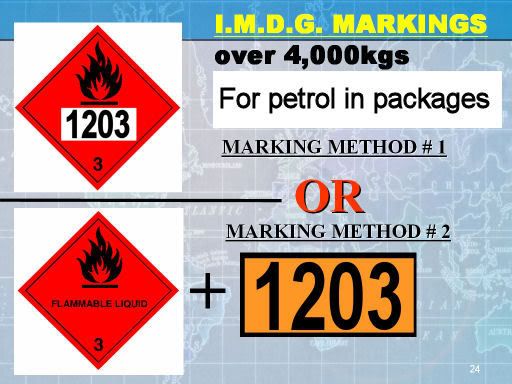
Just because the UN number on an ISO container isn’t required by ADR on the road, it doesn’t mean that it’s illegal to have them on display for the purpose of obeying IMDG. By road, displaying a UN number simply means that you’d be ‘overmarked’ ie. above minimum spec.
Hi Dave,
Here is a scenario I saw last week on a Bulk tipping trailer which passed me:
Firstly no Placards anywhere on the trailer but “hanging” on the back of the tail gate over the “grain hatch” was a large placard as seen on tankers etc (normally on all 4 sides as per ADR regs) was a placard with the chemical code eg 2Y and the UN code and nothing else not even orange plates fornt & rear.
I wonder what would our friends at VOSA or PC Plod & Badger Bill would have to say if they stopped this character.
Just something to add to your previous statement about placards etc. should this driver had been stopped by the above authorities a fine of up to £2,500.00 could have been the result of non-compliance even though the vehicle was empty !
Incidentally as we discussed when I met you in the summer hopefully in the new year I will be looking at the DGSA training course with yourself.
Must go now as “matron” says it is time for tea & biccies before lights out & lock up ![]()
![]()
![]()
![]()
![]()
![]()
Carriage of dangerous goods in ‘bulk.’
Legal definition of “bulk.” ADR 1.2.1
“Carriage in bulk” means the carriage of unpackaged solids or articles in vehicles or
containers. The term does not apply to packaged goods nor to substances carried in tanks;
Typically, the nature of dangerous goods carried in bulk is that they are powders, flakes, granules, pellets, chippings, swarf or shavings etc.
Case study:
Today’s job is to carry magnesium (loose loaded) in a tipper vehicle.
ADR does permit this substance to be carried in bulk.
Our transport document says:
UN 1869 MAGNESIUM, 4.1, PGIII
We need three hazard warning panels like this
Size: 700mm X 300mm
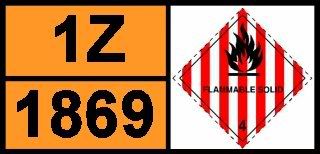
One on the rear and one on each side of the vehicle, plus a normal (400mm X 300mm) plain orange plate on the front of the vehicle.
For those expecting an emergency telephone number, that’s not required for ‘bulk,’ but it is a requirement for tankers.
As an alternative to the ‘traditional’ UK marking system (above,) it is permissible to ‘lose’ the white part of the hazard warning panel above, which then effectively splits the panel into two parts, but splitting the orange part is not allowed. The same rules on the number and positioning of the markings applies though.
The various threshold ‘trigger’ limits ONLY apply to packaged dangerous goods, so for carriage in bulk, ADR applies in full, regardless of the quantity carried. ADR will continue to apply in full, (markings, ADR licence etc) even once the vehicle is offloaded/empty, if there’s any residue of dangerous goods remaining in the vehicle. In order to come ‘out of Regs,’ the vehicle should be correctly washed out by a competent person who signs a document to that effect. This requirement also applies to tankers.
(Whether folks actually do that is up to them though. ![]() )
)
NEJ:
Hi Dave,
Here is a scenario I saw last week on a Bulk tipping trailer which passed me:Firstly no Placards anywhere on the trailer but “hanging” on the back of the tail gate over the “grain hatch” was a large placard as seen on tankers etc (normally on all 4 sides as per ADR regs) was a placard with the chemical code eg 2Y and the UN code and nothing else not even orange plates fornt & rear.
Hi NEJ, Sorry mate, but there’s one or two myths at work here… ![]()
The large sign as used on tankers is called a ‘hazard warning panel,’ and UK registered tankers on domestic transport are required to display three, not four. The other marking to be displayed on the front of a tanker in this situation is called a plain ‘orange coloured plate.’
An ‘orange coloured plate’ (note the absence of the word “plain”) with an ‘EAC’ of 2Y and a UN number is quite legitimate, so the offence is “failed to display placards.” (A placard is diamond-shaped.)
NEJ:
I wonder what would our friends at VOSA or PC Plod & Badger Bill would have to say if they stopped this character.
I’d say he gets a PG9 instant and other enforcement action at the discretion of the officer concerned. Our driver also needed a ‘plain orange-coloured plate’ to be displayed on the front of the vehicle, but we don’t know whether that was present.
NEJ:
Just something to add to your previous statement about placards etc. should this driver had been stopped by the above authorities a fine of up to £2,500.00 could have been the result of non-compliance even though the vehicle was empty !
That only might be true NEJ, but without knowing whether any dangerous goods were actually on board the vehicle, nobody can say for sure. A empty vehicle having carried dangerous goods in bulk is fully ‘in scope’ until it’s been correctly washed out. The requirement to remove ‘plain orange coloured plates’ only applies to empty vehicles having carried packaged dangerous goods.
NEJ:
Incidentally as we discussed when I met you in the summer hopefully in the new year I will be looking at the DGSA training course with yourself.
I’ll send you a PM about that. ![]()
Dieseldave
I recently passed my ADR, (Core, Packages 2,3,4,5,6,8,9 & Tanks) and I have received two certificate’s through the post.
This was first to arrive

and the second arrived the next day.

Is this correct?
Andrew Leitch:
DieseldaveI recently passed my ADR, (Core, Packages 2,3,4,5,6,8,9 & Tanks) and I have received two certificate’s through the post.
This was first to arrive
and the second arrived the next day.
Is this correct?
It simply looks like they didn’t notice that you did tanks as well, but issue 1 is still valid for packages.
The crosses mean you haven’t taken 1 and 7, explosives and radioactives.
Issue 2 is correct, you could put issue 1 on eBay ![]()
Andrew Leitch:
DieseldaveI recently passed my ADR, (Core, Packages 2,3,4,5,6,8,9 & Tanks) and I have received two certificate’s through the post.
This was first to arrive
and the second arrived the next day.
Is this correct?
Hi Andrew,
Firstly, let me say:
![]() CONGRATULATIONS on passing your ADR exams
CONGRATULATIONS on passing your ADR exams ![]()
![]()

![]()
![]()
![]()

![]()
![]()
![]()

![]()



Now to your question…
It’s perfectly normal (and legal) that your final ADR certificate arrives in the way that yours did.
There are a couple of possible administrative reasons for this.
- The tanker module was notified as a separate course number.
- You decided to add ‘tanks’ later than when you took the decision to do the first (packages) part of the course.
- The tanker exam answer sheets were sent to SQA (for marking) in a separate envelope.
Either way though, there’s absolutely no problem with the way that this has been handled by the ADR training provider.
The first certificate is already invalid, because the later “issue number” automatically supersedes the first.
You should always use the ADR certificate with the latest issue number and destroy all previously issued ADR certificates.
In your case, please only use the certificate with issue number “02.”
Anybody (even yourself) caught using issue “01” will be flagged up as suspicious and enquiries will be made.
![]() If you decide to sell the first one on eBay, use the username “Wheel Nut.”
If you decide to sell the first one on eBay, use the username “Wheel Nut.” ![]()
![]()
![]()
![]()
![]()
Thank you dieseldave. ![]()
